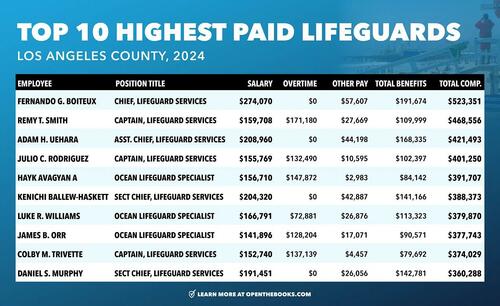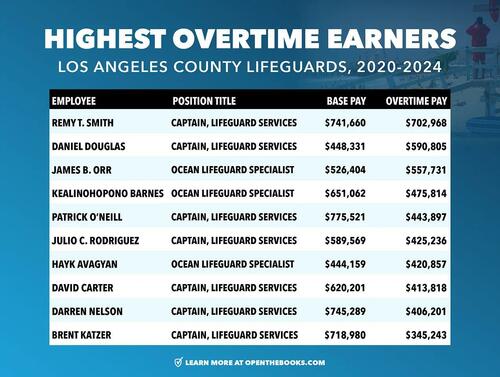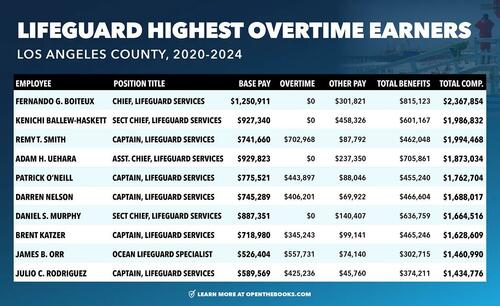


If it wasn’t clear that the city and county of Los Angeles are in dire need of spending resets, taxpayers can look no further than the county lifeguards paid to watch over its pools, lakes and ocean.
OpenTheBooks.com reported on outrageous overtime spending on the LA police, fire and particularly overpaid employees in the city’s Department Water & Power amid out-of-control wildfires in January, and the anti-immigration riots in June.
Lifeguards, too, enjoy big overtime payouts and generous benefits. The top-paid lifeguard in LA county was compensated more than $500,000 in 2024; and over the past 5 years, a single lifeguard was able to pull down $702,000 – in overtime alone!
BY THE NUMBERS
We reported that in 2021, the top-paid lifeguards earned up to $510,283 — back then, we found 98 lifeguards earned at least $200,000 including benefits.
Now, out of over 1,500 lifeguards, 134 of them earned at least $200,000 including benefits. Thirty-four of them had $300,000 or more in their compensation package.
The highest paid in 2024 was lifeguard services chief Fernando Boiteux, who was given $523,351 in base pay, “other pay” and benefits.
Total compensation was $70.8 million for the 134 lifeguards last year, and includes the following: base pay, overtime pay, “other” pay, leave time payouts, health insurance payments, pension contributions, deferred contributions, long-term disability and life insurances, and “other” benefits.
Forty-five lifeguards collected between $50,000 and $171,000 in overtime alone.
In fact, the highest paid overtime earner at $171,000 was lifeguard services captain Remy Smith, who also received $109,999 worth of benefits, for a total compensation package of $468,556, the second highest compensation package behind Boiteux.
Boiteux didn’t collect overtime, but his generous pay package was top heavy with benefits — $192,000, including $100,000 in pension contributions, which is $25,000 more than anyone else.
Following Smith, the next highest overtime earners are ocean lifeguard Hayk Avagyan ($147,872), lifeguard services captain Colby Trivette ($137,139), lifeguard services captain Julio Rodriguez ($132,490) and ocean lifeguard Scott Deboer ($128,873).
The tidal wave of overtime in 2024 isn’t an aberration.
The 10 lifeguards with the most overtime pay took home between $345,000 and $702,000 each over the course of five years. All told, taxpayers have paid out $4,782,570 to those 10 lifeguards since 2020.
When we combine overtime with base pay and other compensation, the highest paid lifeguards in the last five years each took home between $1.4 million and $2.4 million in total compensation:
Top lifeguard officials and ocean lifeguards are employed by the fire department and make up about half of all lifeguards. After 30 years of service, these lifeguards can retire on between 70% and 81% of their pay, depending on which tier of the pension plan they belong to.
Lake and pool lifeguards make up the other half, and are employed by the Parks and Recreation Department, whose pension benefits vary.
Pay for beach lifeguards dwarfs that of their colleagues at the pools and lakes.
The highest paid pool lifeguard was given $65,000 compensation — $53,000 in total pay, and $13,000 in benefits, which is about 12% that of the highest paid ocean lifeguard.
The high pay, overtime and benefits are in contrast with the City of Los Angeles, which only employs its pool lifeguards and open water lifeguards on a part-time basis. The highest paid among the 487 “active” lifeguards made $35,000 in 2024, with just over $1,000 in benefits paid.
That’s not to say these public servants are phoning it in — they’re hard-working men and women, fighting ocean waves to save people from drowning.
DANGEROUS WORK
Ocean lifeguards Max Malamed and Ryan Aronson were given the 2024 Medal of Valor for “performing a difficult and dangerous pier jump into large surf to rescue a distressed patient experiencing a psychiatric crisis,” the LA County Fire Department said.
Paramedic Rescue Boat Captain Brian Kari, Paramedic Ocean Lifeguard Specialist Sean Kennedy, and members of the Avalon City Fire Department were given the Distinguished Service Award for helping a young mother who faced life-threatening complications while giving birth on Catalina Island. They stabilized mother and child, who were then airlifted to the Neonatal Intensive Care Unit on the mainland.
There’s no shortage of heroic stories about lifeguards springing into action, with or without an award.
Last July, firefighters and lifeguards helped rescue five people from a sinking boat that caught fire off the coast.
In March, lifeguards rescued a distressed dolphin that beached itself, and transported it to a marine mammal rescue center.
But heroic actions don’t always translate to higher pay. Aronson took home a modest $54,000 in pay, with $11,000 in benefits, for $65,000 in total compensation.
Malamed earned $165,000 in cash, plus $66,000 in benefits, for a total pay package of $231,000, while Kennedy was the highest paid among the three heroic lifeguards, collecting $232,000 in pay, plus $96,000 in benefits for total pay packages of $328,000.
CONCLUSION
Reasonable people can differ on some of these eye-popping numbers. After all, unlike most bureaucrats, lifeguards put themselves in harm’s way for their pay. But as Open the Books has chronicled, resources are finite and friendly dealmaking with public employee unions can send costs out of control.
County lifeguards like Boiteux can retire relatively early at 50, with plenty of time to pursue other professional projects, while collecting defined pension benefits for years to come. The generous plan allows the employee to choose which 12-month period they’d like to use to calculate their “Final Average Salary,” allowing them to choose the window with their highest average monthly pay. Using the conservative end of the scale, at 70% of base pay, a lifeguard with Boiteux’s base pay alone could continue collecting $191,849 for years to come, plus cost of living adjustments, making them potential multimillionaires when all is said and done.
As new bargains get made, taxpayers deserve to understand the scale of these lifetime payouts as public officials decide how they allocate resources.




